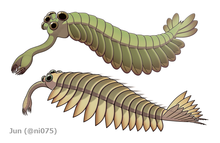Opabiniidae
 From Wikipedia the free encyclopedia
From Wikipedia the free encyclopedia
| Opabiniidae Temporal range: Middle Cambrian - Middle Ordovician, | |
|---|---|
 | |
| Opabinia (top) and Utaurora (bottom) | |
| Scientific classification | |
| Domain: | Eukaryota |
| Kingdom: | Animalia |
| Phylum: | Arthropoda |
| Class: | †Dinocaridida |
| Family: | †Opabiniidae Walcott, 1912 |
| Genera | |
Opabiniidae is an extinct family of marine stem-arthropods.[1] Its type and best-known genus is Opabinia. It also contains Utaurora, and Mieridduryn. Opabiniids closely resemble radiodonts, but their frontal appendages were basally fused into a proboscis. Opabiniids also distinguishable from radiodonts by setal blades covering at least part of the body flaps and serrated caudal rami.[2]


History of study[edit]
Opabiniidae was named by Charles Doolittle Walcott in 1912, alongside its type species Opabinia. Walcott interpreted Opabiniidae as a family of anostracan crustaceans, most closely related to Thamnocephalidae.[3] Opabinia was restudied in the 1970s, and reinterpreted as a stranger animal. Stephen Jay Gould referred to Opabinia as a "weird wonder", and an illustration of Opabinia prompted laughter when it was first revealed at a paleontological conference.[4] In 2022, more Opabiniids were discorvered. That being Utaurora, and Mieridduryn.[2]
Myoscolex from Emu Bay Shale is sometimes suggested to be an opabiniid,[5] but morphological features supporting this interpretation are controversial.[6][2]
References[edit]
- ^ Tamisiea, Jack (8 February 2022). "One of Evolution's Oddest Creatures Finds a Fossilized Family Member - Opabinia, which swam the seas of Earth's Cambrian era some 500 million years ago, was not just a one hit wonder". The New York Times. Retrieved 10 February 2022.
- ^ a b c Pates et al. 2022.
- ^ Walcott 1912.
- ^ Whittington 1975.
- ^ Briggs, D. E. G.; Nedin, C. (1997). "The Taphonomy and Affinities of the Problematic Fossil Myoscolex from the Lower Cambrian Emu Bay Shale of South Australia". Journal of Paleontology. 71 (1): 22–32. doi:10.1017/S0022336000038919. JSTOR 1306537. S2CID 131851540.
- ^ Dzik, Jerzy (2004). "Anatomy and relationships of the Early Cambrian worm Myoscolex". Zoologica Scripta. 33 (1): 57–69. doi:10.1111/j.1463-6409.2004.00136.x. ISSN 1463-6409. S2CID 85216629.
Works cited[edit]
- Pates, Stephen; Wolfe, Joanna M.; Lerosey-Aubril, Rudy; Daley, Allison C.; Ortega-Hernández, Javier (9 February 2022). "New opabiniid diversifies the weirdest wonders of the euarthropod stem group". Proceedings of the Royal Society B: Biological Sciences. 289 (1968). doi:10.1098/rspb.2021.2093. PMC 8826304. PMID 35135344.
- Walcott, Charles D. (13 March 1912). "Cambrian geology and paleontology II: No. 6.—Middle Cambrian Branchiopoda, Malacostraca, Trilobita, and Merostomata". Smithsonian Miscellaneous Collections. 57 (6).
- Whittington, H. B. (26 June 1975). "The enigmatic animal Opabinia regalis, Middle Cambrian, Burgess Shale, British Columbia". Philosophical Transactions of the Royal Society of London. Series B, Biological Sciences. 271 (910): 1–43. Bibcode:1975RSPTB.271....1W. doi:10.1098/rstb.1975.0033. JSTOR 2417412.
